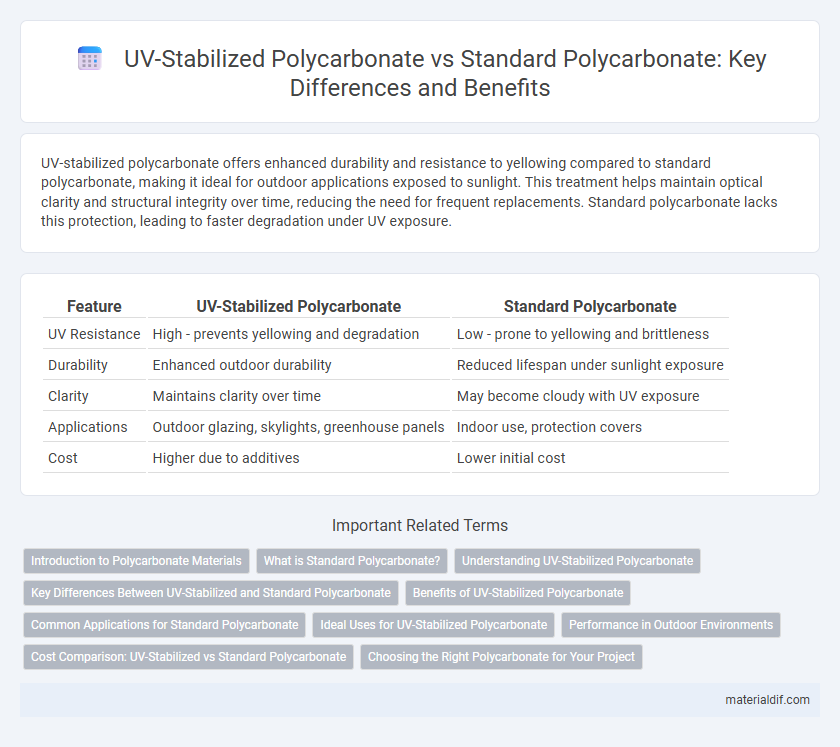UV-stabilized polycarbonate offers enhanced durability and resistance to yellowing compared to standard polycarbonate, making it ideal for outdoor applications exposed to sunlight. This treatment helps maintain optical clarity and structural integrity over time, reducing the need for frequent replacements. Standard polycarbonate lacks this protection, leading to faster degradation under UV exposure.
Table of Comparison
| Feature | UV-Stabilized Polycarbonate | Standard Polycarbonate |
|---|---|---|
| UV Resistance | High - prevents yellowing and degradation | Low - prone to yellowing and brittleness |
| Durability | Enhanced outdoor durability | Reduced lifespan under sunlight exposure |
| Clarity | Maintains clarity over time | May become cloudy with UV exposure |
| Applications | Outdoor glazing, skylights, greenhouse panels | Indoor use, protection covers |
| Cost | Higher due to additives | Lower initial cost |
Introduction to Polycarbonate Materials
UV-stabilized polycarbonate incorporates additives that enhance resistance to ultraviolet radiation, significantly extending the material's lifespan when exposed to sunlight compared to standard polycarbonate. Standard polycarbonate offers excellent impact resistance and optical clarity but tends to yellow and degrade under prolonged UV exposure. The introduction of UV-stabilized variants addresses these durability challenges, making them ideal for outdoor applications such as glazing, roofing, and protective barriers.
What is Standard Polycarbonate?
Standard polycarbonate is a durable thermoplastic known for its high impact resistance, optical clarity, and temperature tolerance, commonly used in applications such as eyewear lenses, automotive parts, and electronic components. It lacks built-in UV protection, making it susceptible to yellowing, brittleness, and degradation when exposed to prolonged sunlight or harsh environmental conditions. Without UV stabilizers, standard polycarbonate requires additional coatings or treatments to enhance its weatherability and extend its service life in outdoor applications.
Understanding UV-Stabilized Polycarbonate
UV-stabilized polycarbonate contains specialized additives that significantly enhance its resistance to ultraviolet radiation, preventing yellowing and degradation over time. This treatment extends the material's lifespan, especially in outdoor applications such as glazing, roofing, and automotive components. Compared to standard polycarbonate, UV-stabilized variants maintain optical clarity and mechanical strength under prolonged sun exposure, making them ideal for environments with intense sunlight.
Key Differences Between UV-Stabilized and Standard Polycarbonate
UV-stabilized polycarbonate contains additives that absorb and dissipate ultraviolet radiation, significantly enhancing its resistance to yellowing and material degradation compared to standard polycarbonate. This makes UV-stabilized polycarbonate ideal for outdoor applications requiring long-term clarity and durability, while standard polycarbonate is better suited for indoor uses where UV exposure is minimal. The enhanced lifespan and maintained optical properties of UV-stabilized variants justify their higher cost in environments with consistent sun exposure.
Benefits of UV-Stabilized Polycarbonate
UV-stabilized polycarbonate offers enhanced resistance to yellowing and degradation caused by prolonged exposure to ultraviolet light, significantly extending its lifespan in outdoor applications compared to standard polycarbonate. This improved durability maintains optical clarity and mechanical strength, reducing maintenance and replacement costs. Its superior UV protection makes it ideal for roofing, glazing, and protective barriers where consistent performance under sunlight is critical.
Common Applications for Standard Polycarbonate
Standard polycarbonate is widely used in applications requiring high impact resistance and optical clarity, such as eyewear lenses, automotive headlamp covers, and electronic display screens. It is favored for protective gear like safety goggles, helmets, and machine guards due to its toughness and lightweight properties. While lacking UV stabilization, standard polycarbonate excels in indoor environments where exposure to sunlight is minimal.
Ideal Uses for UV-Stabilized Polycarbonate
UV-stabilized polycarbonate offers superior resistance to yellowing and degradation caused by prolonged exposure to sunlight, making it ideal for outdoor applications such as skylights, greenhouses, and protective glazing. This material maintains clarity and mechanical strength under intense UV radiation, ensuring long-term durability in harsh environments. Standard polycarbonate, lacking UV stabilization, is more suited for indoor uses where sunlight exposure is minimal.
Performance in Outdoor Environments
UV-stabilized polycarbonate significantly outperforms standard polycarbonate in outdoor environments by offering enhanced resistance to UV radiation, preventing yellowing, and maintaining optical clarity over time. The incorporation of UV inhibitors in stabilized polycarbonate extends its lifespan to over 10 years under direct sunlight exposure, compared to 2-3 years for standard polycarbonate, which typically suffers from surface degradation and embrittlement. This makes UV-stabilized polycarbonate ideal for outdoor applications such as skylights, protective glazing, and greenhouses where long-term durability and transparency are critical.
Cost Comparison: UV-Stabilized vs Standard Polycarbonate
UV-stabilized polycarbonate typically incurs a higher initial cost compared to standard polycarbonate due to the addition of UV inhibitors that enhance durability and resistance to sun damage. Over the long term, the investment in UV-stabilized polycarbonate can reduce replacement and maintenance expenses, offering better value in outdoor applications exposed to prolonged sunlight. Standard polycarbonate may be more cost-effective for indoor or short-term uses where UV exposure is minimal, but it may degrade faster when used outdoors.
Choosing the Right Polycarbonate for Your Project
UV-stabilized polycarbonate offers enhanced resistance to yellowing and degradation caused by prolonged exposure to sunlight, making it ideal for outdoor applications requiring long-term clarity and durability. Standard polycarbonate provides excellent impact resistance and versatility but may suffer from reduced transparency and structural integrity when exposed to UV rays over time. Selecting the right polycarbonate depends on the project's exposure to UV light and environmental conditions, ensuring optimal performance and longevity.
UV-Stabilized Polycarbonate vs Standard Polycarbonate Infographic

 materialdif.com
materialdif.com